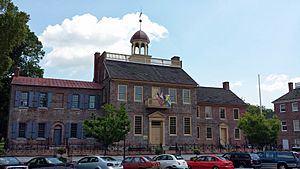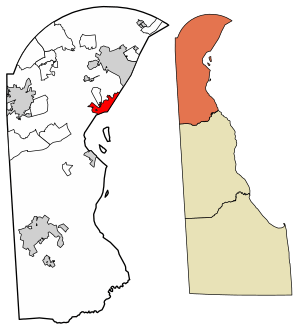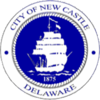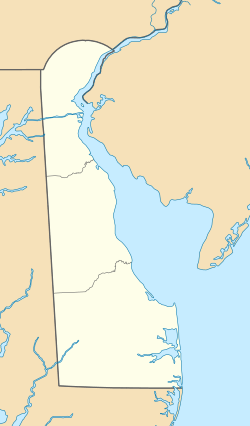New Castle, Delaware facts for kids
Quick facts for kids
New Castle, Delaware
|
|||
|---|---|---|---|

|
|||
|
|||

Location of New Castle in New Castle County, Delaware (left) and of New Castle County in Delaware (right)
|
|||
| Country | United States | ||
| State | Delaware | ||
| County | New Castle | ||
| Founded | 1640 | ||
| Area | |||
| • Total | 3.52 sq mi (9.12 km2) | ||
| • Land | 3.48 sq mi (9.01 km2) | ||
| • Water | 0.04 sq mi (0.11 km2) | ||
| Elevation | 10 ft (3 m) | ||
| Population
(2020)
|
|||
| • Total | 5,551 | ||
| • Density | 1,596.03/sq mi (616.23/km2) | ||
| Time zone | UTC−5 (Eastern (EST)) | ||
| • Summer (DST) | UTC−4 (EDT) | ||
| ZIP codes |
19720-19721, 19726
|
||
| Area code(s) | 302 | ||
| FIPS code | 10-50800 | ||
| GNIS feature ID | 214379 | ||
New Castle is a historic city in New Castle County, Delaware, USA. It's about 6 miles (10 km) south of Wilmington, right on the Delaware River. In 2020, about 5,551 people lived here. New Castle is part of the larger Philadelphia metropolitan area.
Contents
A Journey Through Time: New Castle's History
Early European Settlements
New Castle was first settled by the Dutch West India Company in 1651. This happened under the leadership of Peter Stuyvesant. They built a fort called Fort Casimir on the site of an old Native American village. The village was known as "Tomakonck," meaning "Place of the Beaver."
In 1654, the colony of New Sweden took over the fort. They renamed it Fort Trinity. But the Dutch quickly took back control the next year. They then renamed the fort Nieuw-Amstel, after the Amstel River in the Netherlands. Even though the Swedish colony ended, Swedish culture stayed strong in the area. As the town grew, the Dutch created a street plan and a common green. This green is still there today.
In 1664, the English took over the entire Dutch colony during a war. They changed the town's name to "New Castle." It became the capital of their Delaware Colony. The Dutch briefly got the town back in 1673. But it was returned to Great Britain the next year.
In 1680, New Castle was given to William Penn by the Duke of York. Penn was the founder of Pennsylvania. He first arrived in America in New Castle on October 27, 1682. There was a long argument about the border between Delaware and Maryland. This was finally settled in the 1760s by the Mason–Dixon line.
New Castle in the 18th Century
Before Penn founded Philadelphia, New Castle was an important center for government. After it was given to Penn, the people of Delaware wanted their own government. They were used to a more relaxed way of life. They did not like the strict Quaker rules from Pennsylvania. So, Delaware asked for its own legislature, which it got in 1702.
Delaware officially separated from Pennsylvania in 1704. New Castle became the capital again. The city grew with many judges and lawyers. In 1777, John McKinly became the first President of Delaware. This title was later changed to "Governor."
During the American Revolutionary War, the British attacked New Castle. The government moved its functions south to Dover in May 1777. McKinly was captured by the British. New Castle remained the county seat until after the American Civil War. Then, this role moved to Wilmington. Three people from New Castle signed the United States Declaration of Independence: Thomas McKean, George Read, and George Ross.
New Castle in the 19th Century
New Castle was a busy port. It was part of a 16-mile (26 km) route between the Delaware River and Chesapeake Bay. This route saved a 400-mile (640 km) trip around the Delmarva Peninsula. This brought many people and goods to New Castle.
After the Revolution, a turnpike was built to make travel easier. Later, New Castle became the start of the New Castle and Frenchtown Railroad. This was the second-oldest rail line in the country. It started in 1828 with horse-drawn cars. In 1832, it began using steam engines. The line went across the Delmarva Peninsula to the Elk River in Maryland. From there, people took boats to Baltimore. This helped New Castle's economy grow.
However, by 1840, new rail lines connected Philadelphia and Baltimore. These lines had a stop in Wilmington. This caused New Castle to lose a lot of its traffic and money. This decline actually helped New Castle keep its historic look. Many old buildings were not changed or updated. They still look much like they did in the 1700s and 1800s.
New Castle in the 20th and 21st Centuries
Since 1927, New Castle has offered tours of its historic homes, churches, and gardens. These tours usually happen every May. People dress in old-fashioned clothes. The money from tickets helps maintain the town's historic buildings. Every June, New Castle celebrates its annual Separation Day.
On April 28, 1961, a strong tornado hit the north side of the city. It was an F3 tornado. No one was hurt, but it was the strongest tornado ever recorded in Delaware at that time. Another strong tornado, an EF3, hit the city on April 1, 2023.
Exploring New Castle's Geography
New Castle covers about 3.2 square miles (8.2 km²). Most of this area is land, with a small part being water.
The city is home to Broad Dyke. This was the first dyke ever built in the United States.
The top part of the court house is very important. It is the center of the "Twelve-Mile Circle." This circle helps define much of the border between Delaware and Pennsylvania. It also forms small parts of the borders with New Jersey and Maryland.
Who Lives in New Castle?
| Historical population | |||
|---|---|---|---|
| Census | Pop. | %± | |
| 1850 | 1,202 | — | |
| 1860 | 1,902 | 58.2% | |
| 1870 | 1,916 | 0.7% | |
| 1880 | 3,700 | 93.1% | |
| 1890 | 4,010 | 8.4% | |
| 1900 | 3,380 | −15.7% | |
| 1910 | 3,351 | −0.9% | |
| 1920 | 3,854 | 15.0% | |
| 1930 | 4,131 | 7.2% | |
| 1940 | 4,414 | 6.9% | |
| 1950 | 5,396 | 22.2% | |
| 1960 | 4,469 | −17.2% | |
| 1970 | 4,814 | 7.7% | |
| 1980 | 4,907 | 1.9% | |
| 1990 | 4,837 | −1.4% | |
| 2000 | 4,862 | 0.5% | |
| 2010 | 5,285 | 8.7% | |
| 2020 | 5,551 | 5.0% | |
| U.S. Decennial Census | |||
In 2000, there were 4,862 people living in New Castle. There were 2,012 households and 1,339 families. The population density was about 1,595 people per square mile.
Most people in the city were White (77.48%). About 20.20% were African American. Other groups made up smaller parts of the population. About 2.41% of the people were Hispanic or Latino.
About 26.2% of households had children under 18 living with them. The average household had 2.42 people. The average family had 2.93 people.
The population was spread out by age. About 21.8% were under 18. About 14.4% were 65 or older. The average age was 40 years old.
Historic Places to Visit
The New Castle Historic District is a special area in the center of town. It has about 500 historic buildings. These buildings were built between 1700 and 1940. This area has many well-preserved buildings from the 17th to early 19th centuries. It was named a National Historic Landmark in 1967.
The New Castle Historic District was added to the National Register of Historic Places in 1967. Its boundaries were made larger in 1984. The district covers about 135 acres. It includes the Amstel House and the Old Courthouse. These are also listed separately.
The New Castle Court House, the Green, and the Sheriff's House are part of First State National Historical Park. This park tells the story of Delaware's settlement. It also explains Delaware's role in the founding of the United States.
Some important historic sites in the district include:
- Amstel House: This is the home of the New Castle Historical Society.
- Stonum: This was the home of George Read. He was an important Delaware politician in the 1700s.
- Read House and Garden: This was the home of George Read's son, George Read Jr.. It was built between 1801 and 1804.
- Immanuel Episcopal Church on the Green
- New Castle Court House Museum: This was the original colonial capital building. It was Delaware's first State House. It served as a Court House until 1882. Its cupola helped define Delaware's border with Pennsylvania.
- Old Dutch House: A small, old house built around 1700.
- Thomas McKean House: The former home of Thomas McKean, one of the Founding Fathers.
- New Castle Presbyterian Church: Built in 1707.
- Lesley-Travers Mansion: Built in 1855.
Outside the historic district is Bellanca Airfield. This was once the factory for Bellanca Aircraft Corporation. They built over 3,000 airplanes here from 1928 to 1960. The Delaware Aviation Hall of Fame Museum is now in its hangar. Other nearby historic places include Buena Vista and Penn Farm of the Trustees of the New Castle Common.
Education in New Castle
New Castle is served by the Colonial School District. This district operates William Penn High School.
There are also private schools in New Castle. These include Serviam Girls Academy and St. Peter's Catholic School. Delaware Valley Classical School is another private option.
The New Castle Public Library serves the community.
Getting Around New Castle
Roads and Highways
U.S. Route 13 and U.S. Route 40 are the main highways in New Castle. They run together along Dupont Highway on the city's northwest side.
Delaware Route 9 goes through New Castle. It uses 7th Street, Washington Street, Delaware Street, and Ferry Cut Off Street. This route avoids the historic area. DE 9 goes north to Wilmington and south to Delaware City.
Delaware Route 141 heads north from New Castle on Basin Road. It offers a way to bypass Wilmington to the west. Delaware Route 273 goes west from New Castle on Frenchtown Road. It provides access to Christiana and Newark.
Interstate 295 passes north of New Castle. It crosses the Delaware River on the Delaware Memorial Bridge to New Jersey. DE 9 connects New Castle to I-295.
Air and Rail Travel
The Wilmington Airport is northwest of New Castle. It offers general aviation and commercial flights. It is also home to a unit of the Delaware Air National Guard.
A freight train line runs through New Castle. It is operated by the Norfolk Southern Railway. For passenger trains, the closest station is Wilmington station. This station is served by Amtrak and SEPTA Regional Rail.
Public Transportation
DART First State provides bus service in New Castle. Route 15 and Route 51 connect downtown Wilmington to the Christiana Mall. These routes also connect to other bus lines in northern New Castle County.
City Services
The Municipal Services Commission of New Castle provides electricity and water to the city. Delmarva Power provides natural gas service. The city's Public Works department handles trash and recycling collection.
Famous People from New Castle
Many notable people have connections to New Castle:
- Walter W. Bacon: A former Governor of Delaware.
- John Walter Bratton: A songwriter.
- Thomas Holcomb: A Commandant of the United States Marine Corps.
- Dave May: A former MLB player.
- Thomas McKean: A lawyer and politician who signed the Declaration of Independence.
- Vinnie Moore: A guitarist.
- George Read I: Signed both the Declaration of Independence and the Constitution. He was also a former Governor of Delaware.
- George Ross: Another signer of the Declaration of Independence.
- Jeff Otah: An NFL player.
- Ryan Phillippe: An actor.
- Devin Smith: A professional basketball player.
- Charles Thomas: A former Governor of Delaware.
- Nicholas Van Dyke I: A former President of Delaware.
- Nicholas Van Dyke II: Son of Nicholas Van Dyke I, and a U.S. Senator.
- Jalen Duren: A professional basketball player.
- Joe Biden: Former senator from Delaware and 46th President of the United States.
New Castle in Movies
New Castle has been a filming location for several movies and TV shows. These include Dead Poets Society, Beloved, and River Ridge.
See also
 In Spanish: New Castle (Delaware) para niños
In Spanish: New Castle (Delaware) para niños






